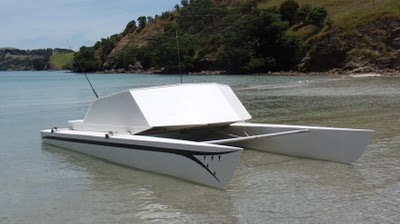
What do you do with a bargain basement priced 35 year old Tornado sailing catamaran when its sailing days are past? I had a couple of choices. I could restore and reinforce the hulls, buy new sails and rigging, and sail it like the designer intended, but somehow I could not see myself righting that 27' rig after a capsize. I could have used the two hulls as amas and built a longer center hull to make a small cruising trimaran. This has been successfully done by others.
Or I could make it into an outboard powered fishing and day cruising boat. The last choice seemed the easiest because not only do I already have a yard full of sailing canoes but I had a 9.9 hp Honda outboard and was interested to see how fast I could drive these hulls.

I tried to keep everything as light as possible while still spending the minimum amount of money. There are four hollow plywood girders bridging between the two original aluminum crossbeams. The deck is 9mm (3/8") Meranti ply. The sides and seats are all 6mm (1/4") ply.
I had to do some test runs to get the motor height just right. You can lose a lot of speed if the prop is too deep and it will ventilate if it is too shallow.
My GPS read a maximum speed of 13.8 knots (25.5 km/h).
Future work will involve reducing the spray from the engine that hits the aft crossbeam and possibly fitting a dodger/awning for sun and wind protection.
And in true outrigger style, the entire platform is lashed to the crossbeams with polyester line.
I have to admit that I was partially inspired to do this by Russell Brown's "Skeeter", although his is designed for rougher conditions than mine.

What a nice idea! It looks fine too, nice proportions to the bridge work so that the sail craft seems naturally adapted to its new motor-life. Easily beachable, fast enough, and recycled -- what could be better?
ReplyDeleteSweet! I like how it looks like a yacht flybridge that is missing the yacht! For the most part, I think this type only makes sense when the hulls are donated - building the whole thing from scratch would be a lot of work compared to a monohull skiff.
ReplyDeleteCheers, Michael
This is just the solution proposed to someone's need on Wooden Boat Forum for a flyfishing machine. I can see your wife really enjoying the fishing from this boat. Did you see Mike L's (of Multimarine and the L7) version using raised Nacra 6.0 hulls? Great little power cats! I'm thinking of incorporating some of this into the Double Tamanu version 2.0. I do have a two stroke 9.9 hp that might be pretty slick in a pod attached to the center deck... Your creativity is continuing to inspire!
ReplyDeleteDan
Nice Job Admiral Dierking
ReplyDeleteThat's quite a fleet you're accumulating, yet another arrow for the quiver!
I have just finished a 20' cat hull and there was not enough buoyancy so I added a smaller modified center hull == my Tri.
ReplyDeleteAdded an 18 HP Tohatsu --- goes exceptional well and paced at 38 knots on flat water --- a bit scary --- 25 K is ample
Cheers Michael
Hi, blast from the past maybe but could you post some pictures of your boat please? It sounds like a great (and quick) little thing!
DeleteVery nice!
ReplyDeleteI love this idea and am thinking of doing the same. Im just wondering what is its width overall? How does it handle in rough water? And what modifications, if any, would you make if you built another one?
ReplyDeleteI used the original aluminum cross beams and they were 10 ft (3 M). If you want to pull it around on a trailer, you'll have to reduce it to whatever your area allows for maximum width. I never had it in really big seas but had no problems there. Russel Brown in Washington state put his deck higher on struts for very rough conditions. I can't really think of anything I would change for my area. A different shaped hull with a flat run aft would probably make a better power boat if you wanted to go faster.
Delete